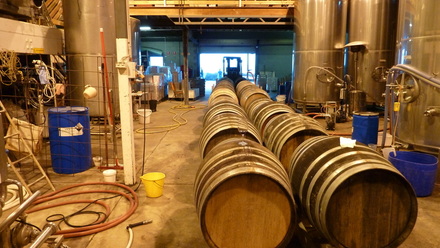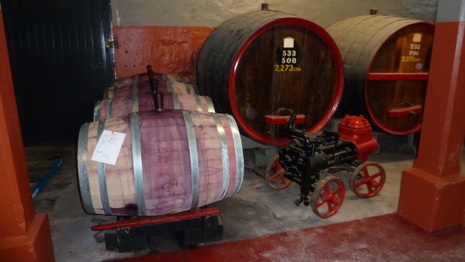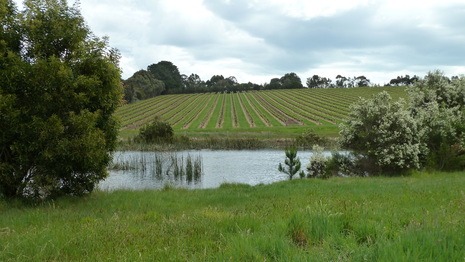n
Why questions, however, are valuable in the context of deductive tasting. They speak to cause and effect in regards to why a wine looks, smells, and tastes the way it does. Cause and effect relationships are also incredibly useful for the student learning about classic grapes and wines in tasting practice, especially the deductive-thinking part of deductive tasting. With that, here are potential cause-effect relationships for all the criteria in the deductive tasting grid.
Sight
Sight is the most overlooked aspect of tasting; an irritating pun at best, but remarkably true as far as cause and effect is concerned. With experience, a quick look at a glass of wine—especially red wine—can and should build multiple expectations on the part of the taster in regards to the possible grape variety, fruit profile, structural elements including the level of alcohol and acidity, and the possible use of oak. Here is the “sight” grid broken down into cause and effect elements:
Clarity: is the result of how much, if any, fining and filtration a wine undergoes during the latter stages of the winemaking process. The clarity scale ranges from a cloudy wine that’s completely unfined and unfiltered to a crystal clear wine that’s put through considerable fining and filtration—and everything in between.
Brightness: brightness in wine—especially in white wines—is a function of clarity which again is a direct result of the degree of fining and filtering. Brightness in reds is largely depends on the depth of pigmentation in various grape varieties. Thinner-skinned, lighter-pigmented grapes such as Pinot Noir and Gamay will reflect far more light than wines made from Syrah or Cabernet Sauvignon.
Intensity of color: in white wines the depth and intensity of color is the result of the climate of origin (ripeness and cool vs warm climate) as well as the overall age or oxidation in the wine due to use of oak or time in bottle. Botrytis-affected fruit may also play a role in a deeper-colored white wine. With red wines, intensity of color is largely due to the depth of pigmentation in a specific variety and likewise the age and oxidation of the given wine.
Primary colors: the base color of a white wine—be it straw, yellow, gold, or brown—is largely determined by the degree of oxidation which can be the result of winemaking or time spent in barrel or bottle. Skin contact and the presence of botrytis can also contribute to a deeper color. In red wines the primary color—purple, ruby (red) or garnet (reddish brown)–is again determined by the depth of pigmentation found in the specific grape (Pinot Noir vs. Syrah) and the age and/or oxidation in the wine.
Secondary colors: in white wines the color green derived from chlorophyll can signify either youth and/or a wine produced from grapes grown in a cooler climate. Platinum, silver, and unpolished brass often accompany the color green in a young white wine. With red wines, secondary colors usually refer to rim variation or the difference in color between the core of the glass and the edge/rim of the glass (see below).
Rim variation: as just described, rim variation (not significant for white wines!) is a term used to denote the color differentiation between wine in the center/core of the glass and wine at the edge/rim. The cause has to do with the amount of pigmentation in the specific grape, climate of origin, the ripeness level of fruit at harvest, and age of the wine. Generally, the older the wine the more rim variation and the more evolved the color at the edge/rim of the glass.
Sediment: sediment in a glass of red wine is due to either age (pigments and tannins precipitating out of solution) or non-filtration in the case of a younger red wine. Tartrates, or tartaric acid crystals, in either white or red wine is the result of the wine not having been cold stabilized or having been minimally fined and filtered.
Gas: CO2 bubbles in the glass can be a by-product of primary fermentation, malolactic conversion, or from CO2 added to the wine as a preservative before bottling.
Tears/legs: while often debated and certainly not hard science, the tears/legs in a glass of wine are the first indication of possible levels of alcohol and/or residual sugar. Thin, quickly moving tears often equate to a lower alcohol level and the lack of residual sugar in the finished wine. By contrast, thick, slowly moving tears are associated with higher levels of alcohol and possible residual sugar.
Staining of the tears: in red wine is result of the depth of pigmentation in the specific grape as well as elevated levels of dry extract in the wine (dissolved solids in solution). Dry extract is further related to lower yields, age of vines, and the degree of fining/filtration used in the winemaking process.
The aroma of a wine is derived from a myriad of influences including the specific grape variety, climate of origin, harvest timing and condition, and any number of winemaking practices. Here is the “nose” grid broken down into cause and effect elements:
Fault factor: does the wine smell clean and well-made or does it contain one or more common wine faults? These include TCA (from faulty corks or contaminated tanks or barrels), high VA (problematic fermentation); Brett (vineyard, barrel, or winery hygiene issues); reduction in the form of H2S or mercaptan (nutrient-deficient must during fermentation); or excess SO2 added at the time of bottling.
Intensity of aroma: the overall intensity of aroma can be related to the specific grape variety, the climate of origin (ripeness levels), structural elements (high alcohol), and winemaking influence in the form of ML, oak usage, and more.
Age: youth vs. an evolving wine vs. a wine showing vinous character is due to either the actual age of the wine, oxidative winemaking (extensive racking, not topping up, etc.), or extended wood-aging.
Primary and secondary fruit: specific kinds of fruit(s) smelled in wine are derived from esters and other aromatic compounds naturally found in the specific grape(s) as well as the result of fermentation. The degree of ripeness or condition of the grape (botrytis) at harvest can also play a part.
Quality of fruit: the quality of the fruit character be it tart, ripe, or jammy, is the result of the climate of origin, specific harvest year (warm vintage etc.), harvest timing (late harvest, passito etc.), and the overall age/oxidation of the wine.
Non-fruit: derived from esters and aromatic compounds found in the specific grape, the condition of the grape (botrytis) at harvest or fermentation, and from the winemaking itself. It’s important to note that many so-called “impact compounds” that are vital markers for classic grapes and wines are part of the non-fruit category.
Inorganic earth: the presence of inorganic and organic earth qualities in wine is largely due to the role of the micro biome in a given vineyard soil; further how specific strains of bacteria and yeasts influence fermentation. The role micro-flora/fauna and ambient yeast populations found in vineyard soil play in fermentation has yet to be determined much less completely understood.
Organic earth: same as above: the origin, specific soil type, and micro-organic life found in the vineyard where the grapes were grown. The presence of Brettanomyces and/or Dekkora from the vineyard or the winery environment should also be considered as a possible cause of earthiness.
Wood: the use of oak during winemaking process for fermentation and aging lends a wide range of aromas from vanilla (vanillin) to brown spices, coffee, tea, chocolate, toast, smoke, dill and more. The age, size, and type of barrel all play an important role in the intensity of wood influence in the finished wine.
Oddly enough, actually tasting a wine in the context of the deductive grid only has two purposes: to confirm what has already been smelled and to determine the level of structural elements including acid, alcohol, and tannin (if applicable). Here is the “palate” grid broken down into cause and effect elements:
Sweetness/dryness: wine is either fermented dry or contains a varying amount of residual sugar due to the fermentation being stopped by sterile filtration, the addition of SO2, or fortification.
Body: is determined by a number of factors including the level of alcohol/glycerin in the wine and the level of dry extract (particulate matter in solution). The latter is further determined by the quality of fruit and the degree of fining and filtration used.
Fruit: once again, specific kinds of fruit(s) smelled in wine are derived from esters and other aromatic compounds naturally found in the specific grape(s) as well as the result of fermentation. The condition of the grape (botrytis) at harvest can also play a part.
Quality of fruit: often changes from nose to palate and is again determined by the ripeness level of fruit at harvest, the specific harvest year (warm vintage etc.), harvest timing (late harvest, passito etc.), and the overall age/oxidation of the wine.
Inorganic/organic earth: the origin, specific soil type, and micro-organic life found in the vineyard where the grapes were grown all contribute to mineral/earth qualities on the palate of a wine. The possibility of Brett as a factor for earthiness must again be considered.
Oak: due to the use of oak during winemaking process for fermentation and aging.
Alcohol: the product of the ripeness of fruit at harvest or other means used to either increase (chaptalization) or decrease (cross-flow, reverse osmosis, watering back, etc.) potential alcohol in the finished wine.
Acidity: ripeness of fruit/level of acidity at harvest or the addition of tartaric acid to fermenting must or the finished wine.
Tannin: is derived from grape skins during pre- and post-fermentation maceration as well as the addition of press wine. Cooperage also plays an important role in the level of tannin in a wine as far as the duration of time wine is kept in barrel, the size and type of cask, and the percentage of new vs. used oak used. Powdered tannin is also commonly added at several different points during the fermentation and aging of red wine where legally allowed.
Finish: the length and quality of the finish is determined by the quality of the fruit combined with the intensity of certain structural components (alcohol, acidity, and tannin) and winemaking practices such as ML, lees contact, and the use of oak.
Complexity: although arguably the most subjective aspect of the deductive grid, the degree of complexity is largely determined by the vineyard origin, quality of the fruit/harvest, and winemaker’s skill–or lack thereof.
After collecting all the “evidence” seen, smelled, and tasted in the wine, the conclusion is based on previous memory/experience using if-then logic. Here cause and effect still play a vital role in deductive thinking in helping to determine Old vs. New World, grape variety, origin of the wine, level of quality, and the specific vintage. Following is the “conclusion” grid—both initial and final– broken down into cause and effect elements.
Initial Conclusion
Old World Style vs. New World Style: largely influenced by the specific location of the vineyard. Winemaking techniques such as blending different appellations and/or varieties, high alcohol, excessive oak, and considerable filtration can also play a part in influencing or obscuring style.
Climate: the specific location of the vineyard and given conditions of a specific growing year (cool vs. warm vintage).
Grape variety: classic markers for specific grapes along with factors such as pyrazines (Cabernet family grapes including Sauvignon Blanc), rotundone (Syrah and Grüner Veltliner), and more.
General age: determined by the overall degree of oxidation (or lack of) perceived in the wine.
Final Conclusion
Grape variety(s): from classic markers and specific factors perceived in the wine.
Country, region, appellation (if applicable): specific origin of the wine
Quality level: balance and typicity of the wine as well as the origin and respective laws if applicable.
Vintage: quality of the wine as related to vintage character as far as specific attributes (ripeness, structural elements).
nn



